Make just a 20% deposit today and pay the remainder 30 days before your departure date. Your journey awaits! ✈️
Valley of Flowers trek is one of the most beautiful treks in India, this also happens to be one of those treks where a lot of trekkers begin their journey of exploring the Himalayas. Located in the Nanda Devi Biosphere, Valley of Flowers is a UNESCO World Heritage site and also India's largest natural botanical garden. One of Uttarakhand's most scenic destinations is the two adjoining treks, Valley of Flowers and Hemkund Sahib conveniently positioned between Joshimath and Badrinath. Ghangaria to Valley of Flowers can be conveniently covered as well. Ghangaria to Valley of Flowers distance is 4km. Joshimath to Valley of Flowers distance is 21km.
Click Here for A Detailed Video Walkthrough of the Valley of Flowers Trek
Visit the abode of various species of flowers!
Valley of Flowers altitude around 3,600 m. The Valley of Flowers National Park opens up in a floral splendour from June up until September every year. A good 500 different species bloom and carpet the valley during this time. The riot of colours that trekkers get to see during this time period is beyond what words can describe. For us, the best time to visit the Valley of Flowers is anywhere between mid of July - August end.
Valley of Flowers Himalayas - Acclimatize in Auli
On the trek to the Valley of Flowers, you will be acclimatising in Auli. It is India's most popular ski destination - Auli on the first two days of the trek. Head out to the beautiful Gorson Bugyal for an acclimatization trek.
Visit here to check out Valley of Flowers trek difficulty.
Have hot langar by an Alpine Lake at 15,200 ft (4,633 m)
The Valley of Flowers trek is incomplete without an exhilarating climb to the world's highest Gurudwara Shri Hemkund Sahib. Nestled in the backdrop of the pristine Hemkund lake is the holy Gurudwara which is visited by thousands of devotees and trekkers every year. The highest valley of flowers height in feet is 15,200. (Click here to read a detailed photo blog on our Hemkund Sahib Trek)
Visit Panch Prayag
Travel via the five sacred river confluences in the Garhwal Himalayas. Devprayag, Rudraprayag, Karnaprayag, Nandaprayag and Vishnuprayag in the ascending flow sequence of their occurrence.
- Devprayag is the confluence of the two holy rivers, the Bhagirathi - the chief stream of the Ganges and the Alaknanda. It is the first Prayag on the way to Badrinath. Beyond this confluence, the river is known as the Ganges.
- Rudra Prayag is the confluence where the river Alaknanda meets the Mandakini River. The confluence is named after the god Shiva, who is also known as Rudra.
- Karn Prayag is the location where the Alaknanda River is joined by the Pindar River which originates from the Pindar glacier, below the Nanda Devi Mountain range.
- Nandaprayag is the confluence where the Mandakini River joins the main Alaknanda River.
- Vishnuprayag - The Alaknanda River, which originates from Satopanth glacier is joined by the Dhauli Ganga River near Joshimath (on Joshimath - Badrinath route). Alaknanda flows in front of the Badrinath temple, one of the most revered Hindu shrines.
Visit here to check out Valley of Flowers trek best time.
The stunning views on Valley of Flowers Uttarakhand trek!
The trail to Gorsan Bugyal gives you a good close-up view of the revered Mt. Nanda Devi along with other peaks such as Mt. Chaukamba, Mt. Dronagiri, Hathi Parvat, Ghoda Parvat and many more. All of this makes this trek a perfect escapade from the monotony of daily life. The landscapes will surely make you fall in love with photography.
Hemkund Sahib Valley of Fllowers trek- See animals that reside in the Biosphere
Valley of Flowers location is endowed with a diverse range of endemic flora, it is picturesque in its beauty. This lush region is also home to some rare and endangered animal species. You may spot animals like Asiatic Black Deer, Snow Leopard, Musk Deer, Red Fox, Brown Bear, and Blue Sheep.
Important Valley of Flowers trek Links:
- For queries regarding the trek: Go to our Valley of Flowers FAQs page and find answers to all your question.
- For a detailed guide on Valley of Flowers: Read this comprehensive Valley of Flowers Guide to help you understand all you need to know about the Valley of Flowers trek!
- To see how the Valley looks during the monsoons: Check out this photoblog of 45 stunning pictures captured during the monsoon trek to Valley of Flowers.
- How to get fit for the Valley of Flowers trek: Click here to read a detailed blog on preparing for the Valley of Flowers trek.
- Wondering what to carry for the trek: Read this blog with a detailed list of things to carry for the Valley of Flowers trek.
- Visit here to know more about the Valley of Flowers trek package.
- Visit here for Valley of Flowers trek cost and dates.
- Visit here for Valley of Flowers trek itinerary.
- Day 1 - Arrive at Rishikesh
- Day 2 - Travel to Auli (Travel via the 4 holy confluences of River Ganga - Devprayag, Rudraprayag, Karnaprayag, Nandprayag)
- Day 3 - Acclimatization trek to Gorsan Bugyal
- Day 4 - Drive to Govindghat via Joshimath and Trek to Ghanghariya
- Day 5 - Trek to Hemkund Sahib - Highest Gurudwara in the World
- Day 6 - Trek to Valley of Flowers - UNESCO World Heritage Site
- Day 7 - Trek to Govindghat from Ghanghariya and travel to Badrinath and Mana* (Travel via the 5th holy confluence of River Ganga - Vishnuprayag). Ghangaria to valley of flowers distance is 4 km.
- Day 8 - Travel to Rishikesh
- Day 9 - Travel back to your city
Valley of Flowers Trek Detailed Itinerary:
Day 1: Rishikesh
Altitude: 1,030 ft (312 m)
Arrive in Rishikesh and check into the hotel. The day is at leisure, and you can utilise it to explore Rishikesh. In the evening, head out to witness the magnificent Ganga Arati at the Triveni Sangam and explore the authentic local cultures of India. Stay the night at Rishikesh.
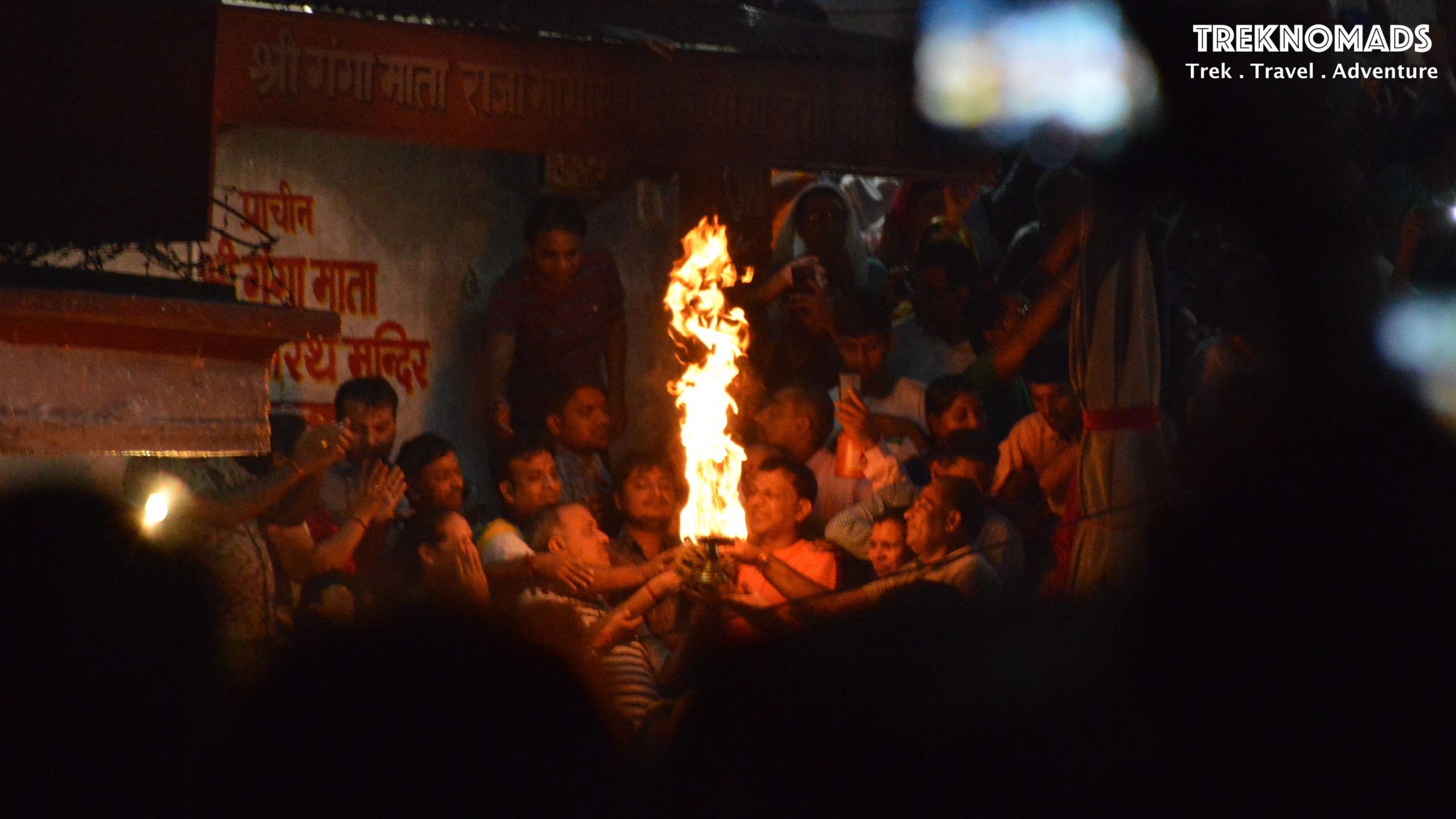
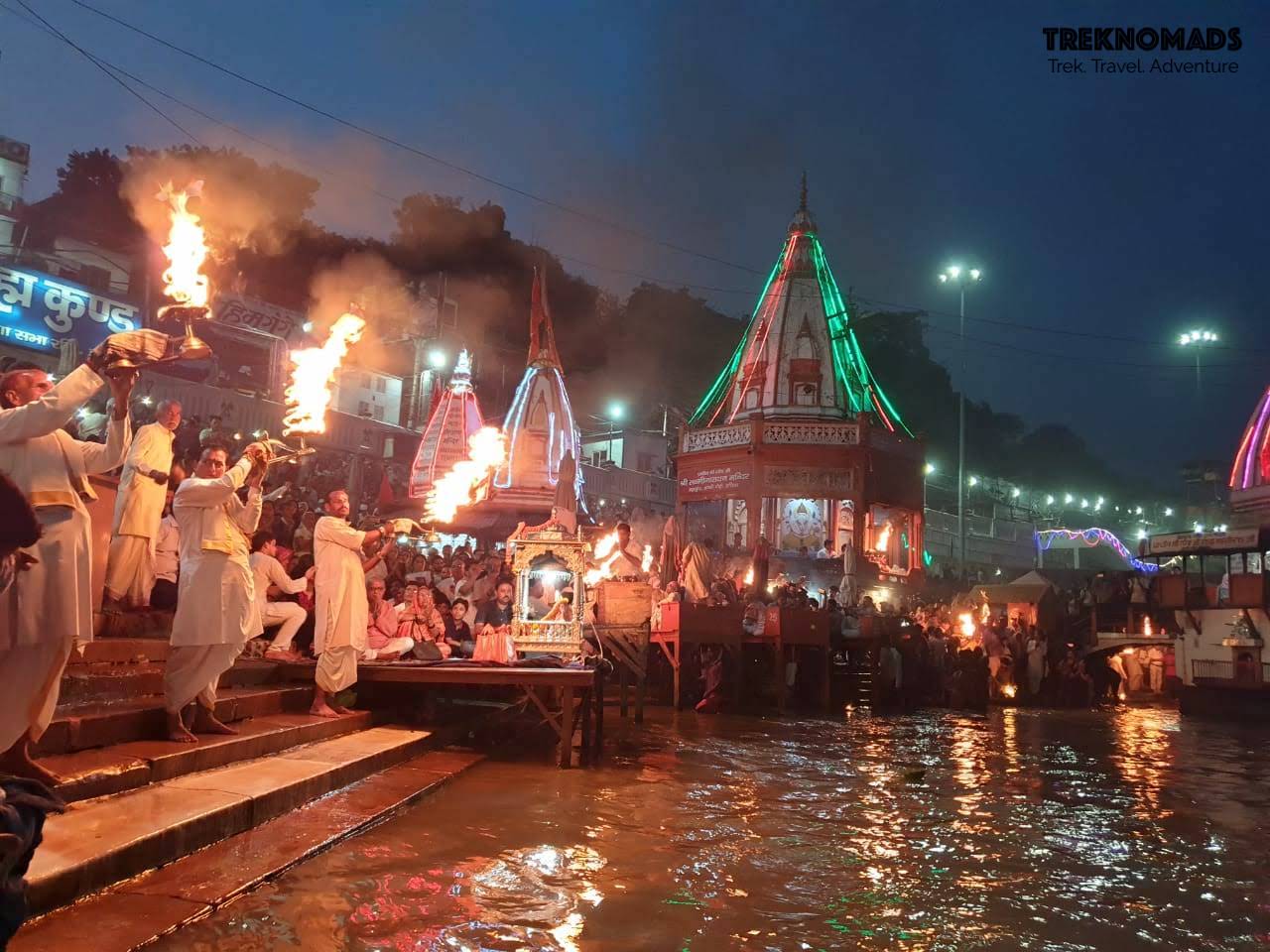
The revered Ganga Arati is something that we do not miss during our treks in Uttarakhand.
Day 2: Auli
Altitude: 8,202 ft (2,500 m)
Travel Distance / Duration: 270 kms / 8-10 hours
On day 2 of hemkund sahib valley of flowers trek, you start your journey from Rishikesh to Auli. Witness the four confluences of the sacred River Ganga (Devprayag, Rudraprayag, Karnaprayag, Nandprayag) en route and also get the very first glimpse of the snow-clad peaks when you're about to arrive in Auli. Check in to the hotel and stay the night at Auli.

The drive from Rishikesh to Auli is super rewarding with views of endless mountains and rivers flowing alongside.
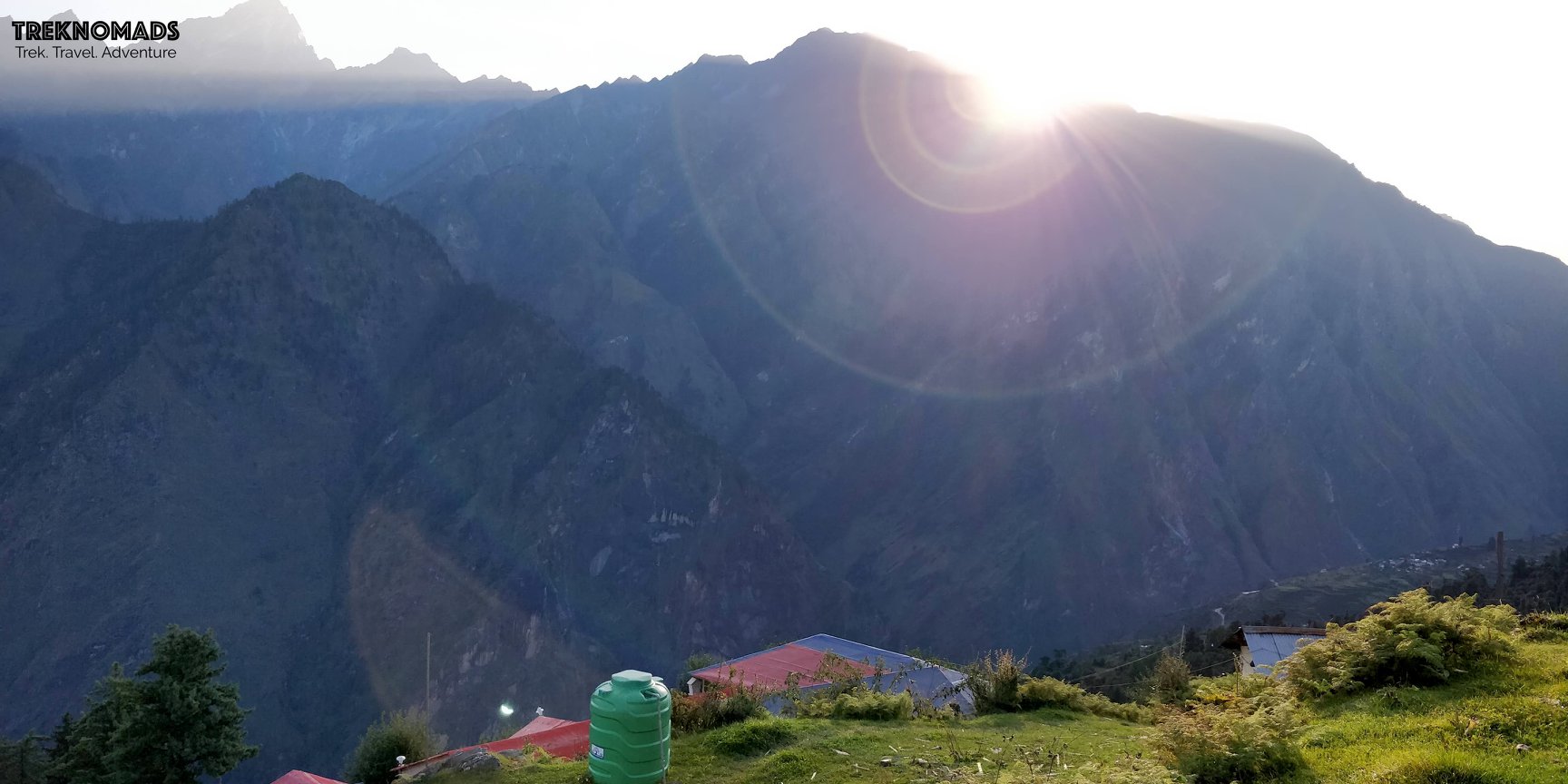
We thrive for sunrises, and the sunrise on your first morning in Auli is something you should definitely not miss!
Day 3: Gorsan Bugyal
Altitude: 10,544 ft (3,214 m)
Trek Distance / Duration: 7-8 kms / 5 hours
According to day 3 of valley of flowers uttarakhandvalley of flowers trek itinerary, wake up early in the morning and head out on an acclimatization trek to the extremely beautiful Gorsan Bugyal. Valley of flowers height is 13,000 ft. So acclimatisaion is important. Pass through one of India's high altitude man-made lakes - Chenab Lake and also get a good view of the revered Mt. Nanda Devi along with other peaks such as Hathi Parvat, Ghoda Parvat and Mt. Dronagiri. Stay the night in Auli.
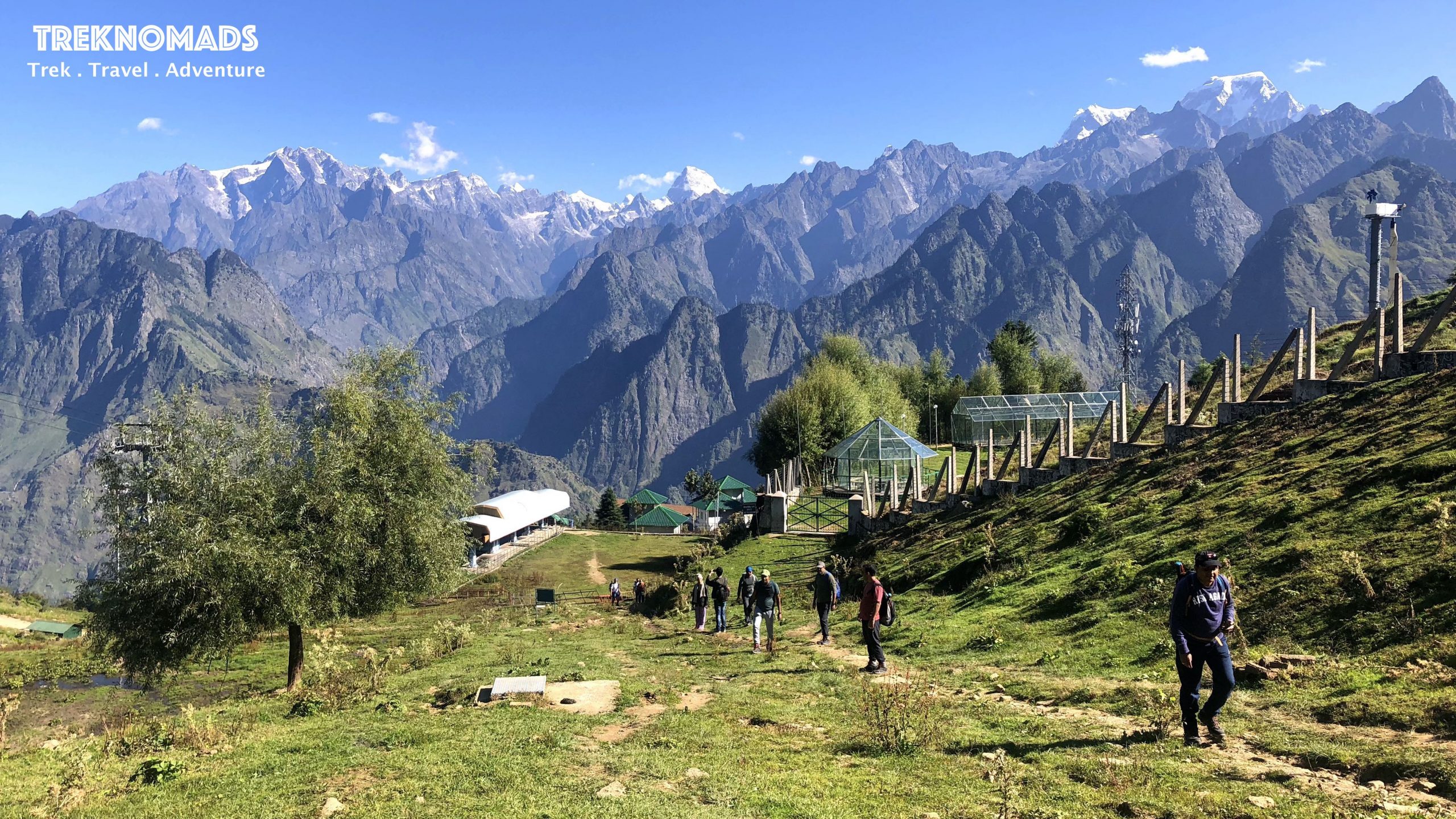
The trek to Gorson Bugyal is quite a sight to behold as seen in the picture. The further you trek, the more the snow clad mountains open up. Best time to visit valley of flowers is June onwards.
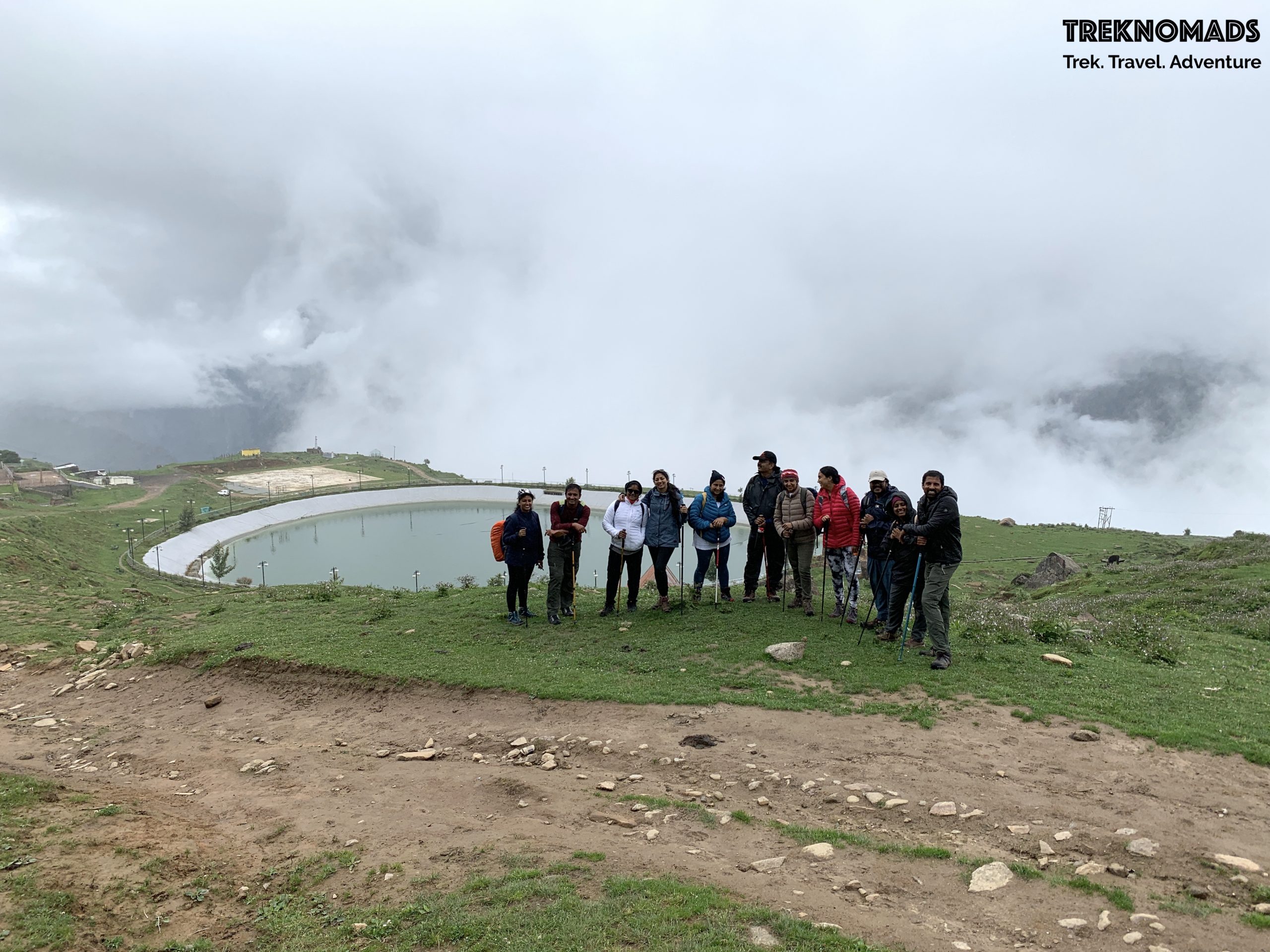
One of the attractions of the Gorson Bugyal trek is the man-made lake you see on the way.
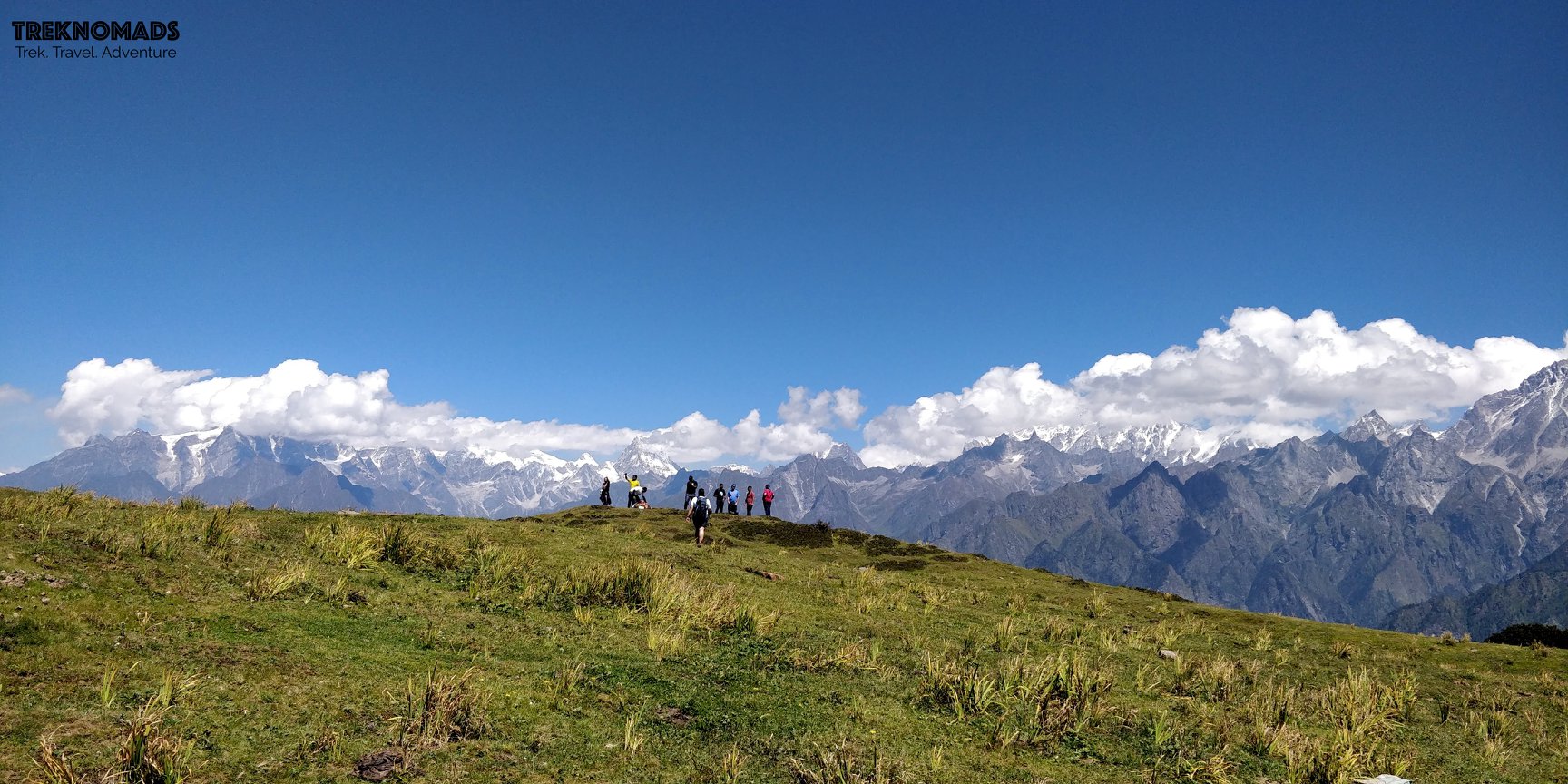
The view after reaching Gorson Bugyal is incredibly satisfying.
Day 4: Govind Ghat to Ghangariya
Altitude: 10,003 ft (3,049 m)
Trek Distance / Duration: 10 kms / 5-6 hours
On Day 4 of the valley of flowers trek uttarakhand, you start your journey towards Govindghat via Joshimath and then start your trek to Ghangariya.The route all through to Ghangariya from Govindghat is man-made with rest stops, shops all along the way. You will also find a lot of pilgrims trekking up to Gurudwara Shri Hemkund Sahib. Get a good glimpse of the confluence of Bhyunder Ganga and river Pushpavati which forms the Lakshman Ganga. Stay the night in Ghangariya. DM us to check valley of flowers trek package.
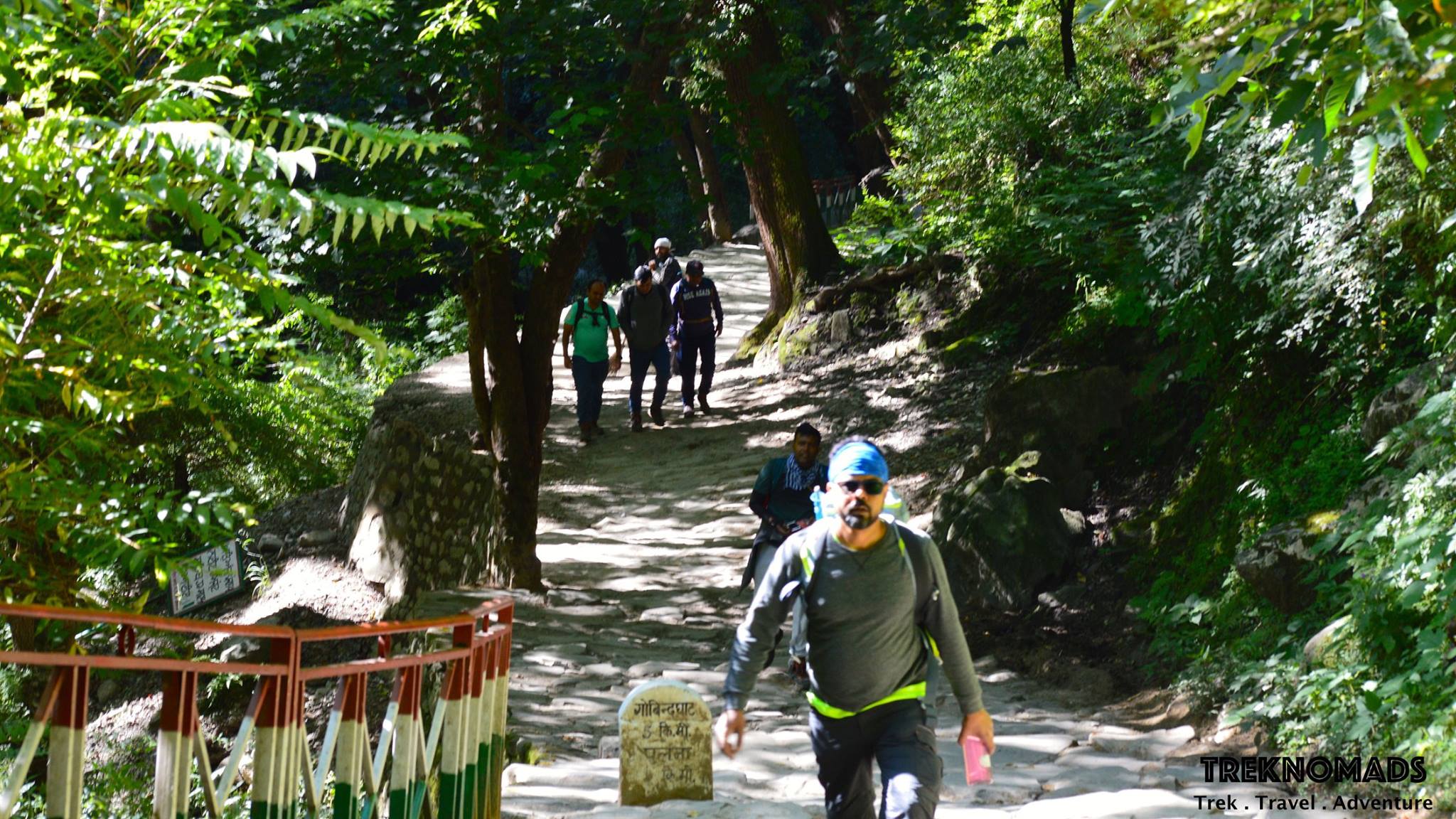
The well-made trail to Ghangariya offers many rest stops, dhabas and washrooms/water fill-up points.
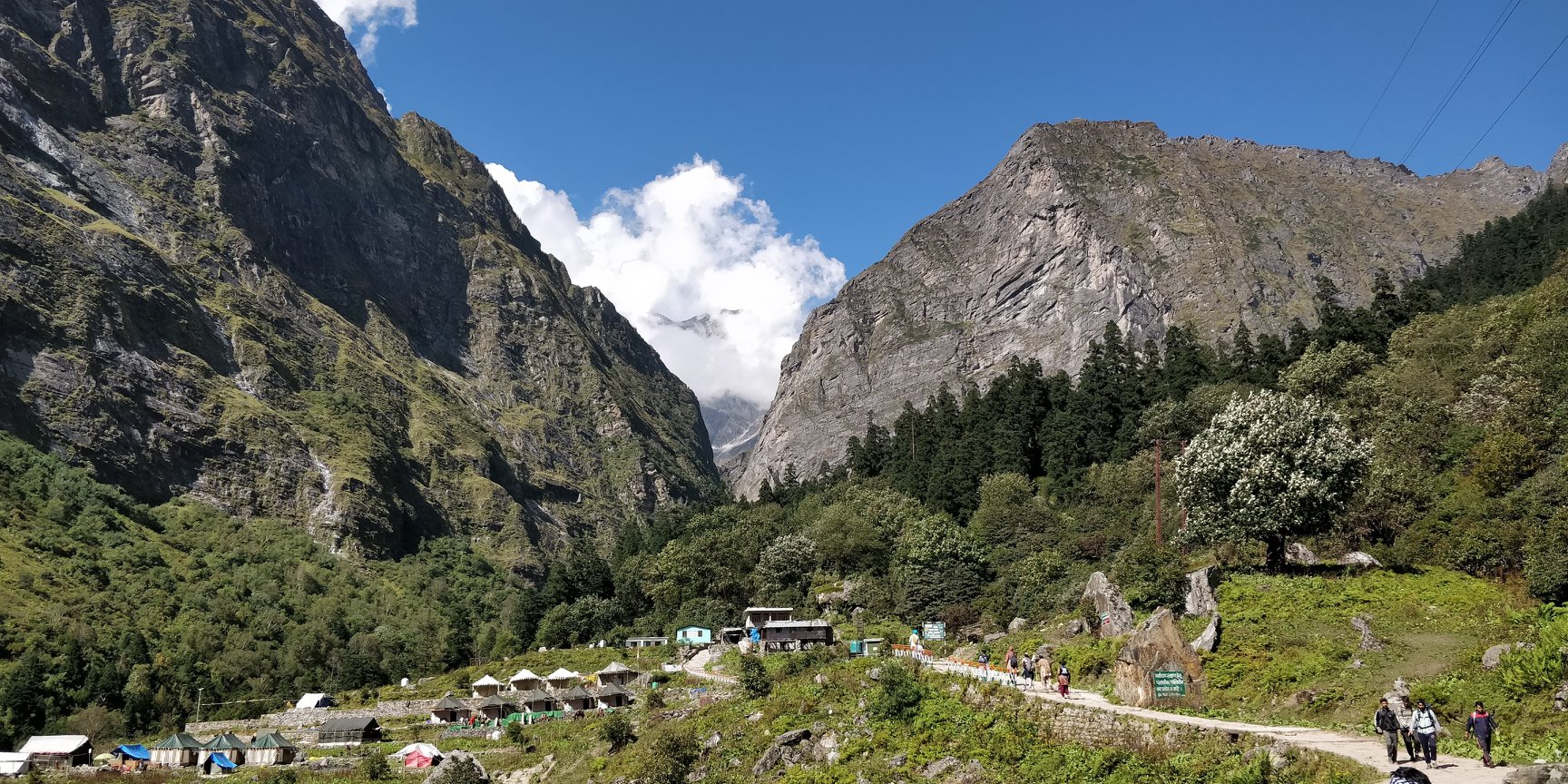
The first glimpse of Ghangariya
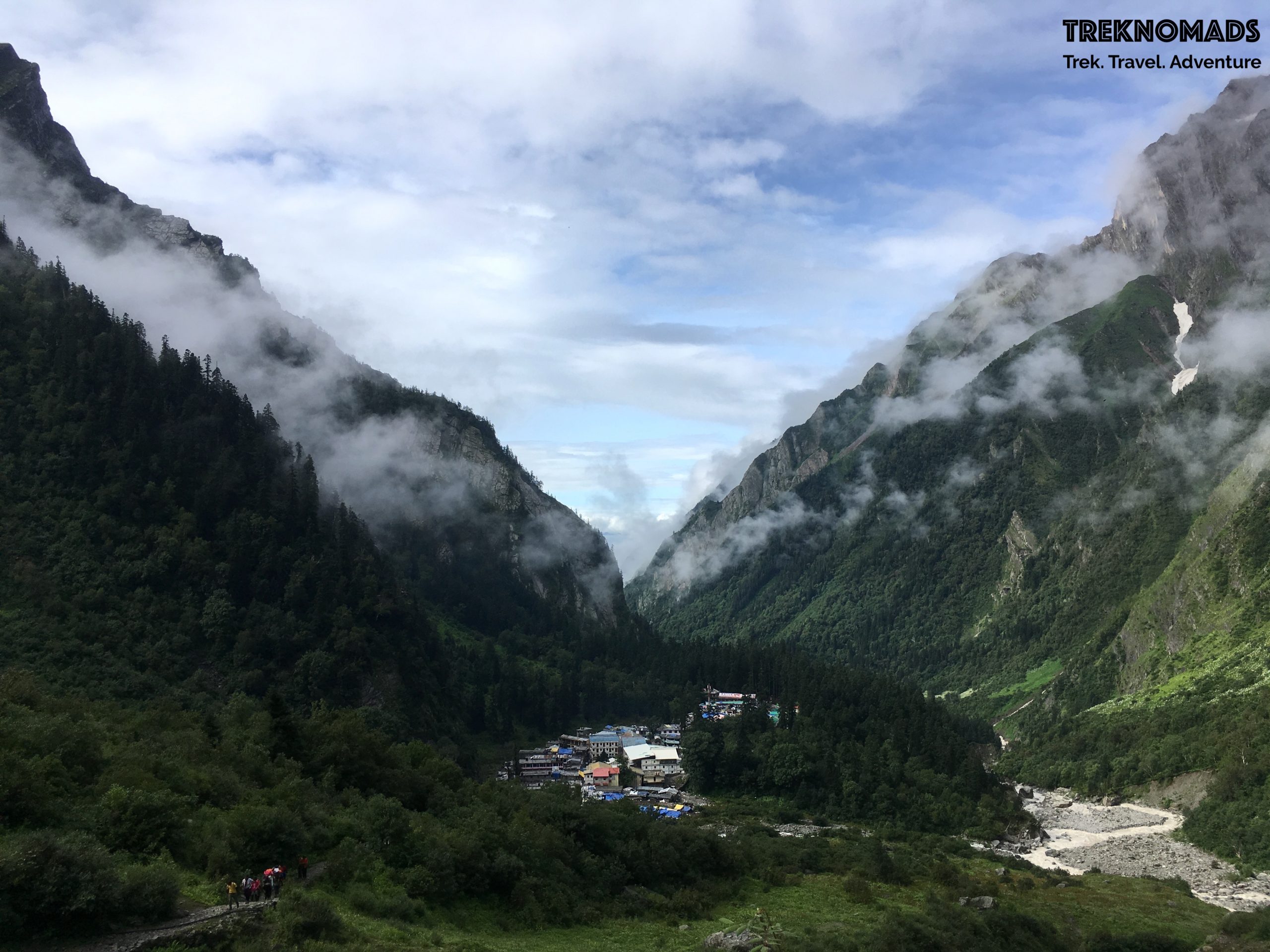
A birds-eye view of the small town of Ghangariya nestled amidst the mountains. This view can be seen from the Hemkund Sahib trek trail.
Day 5: Hemkund Sahib
Altitude: 15,200 ft (4,633 m)
Trek Distance / Duration: 14 kms / 7-8 hours
Today's trek to the Gurudwara is tedious yet the whole vibe is extremely pious and positive. You can hear the chants from the Gurudwara all through the trail. The winding trail also passes through a forested region before opening up and giving you a glimpse of the surrounding peaks. After paying your respects at the Gurudwara you can also visit the gorgeous alpine lake - Hemkund, behind the Gurudwara. Stay the night in Ghangariya.
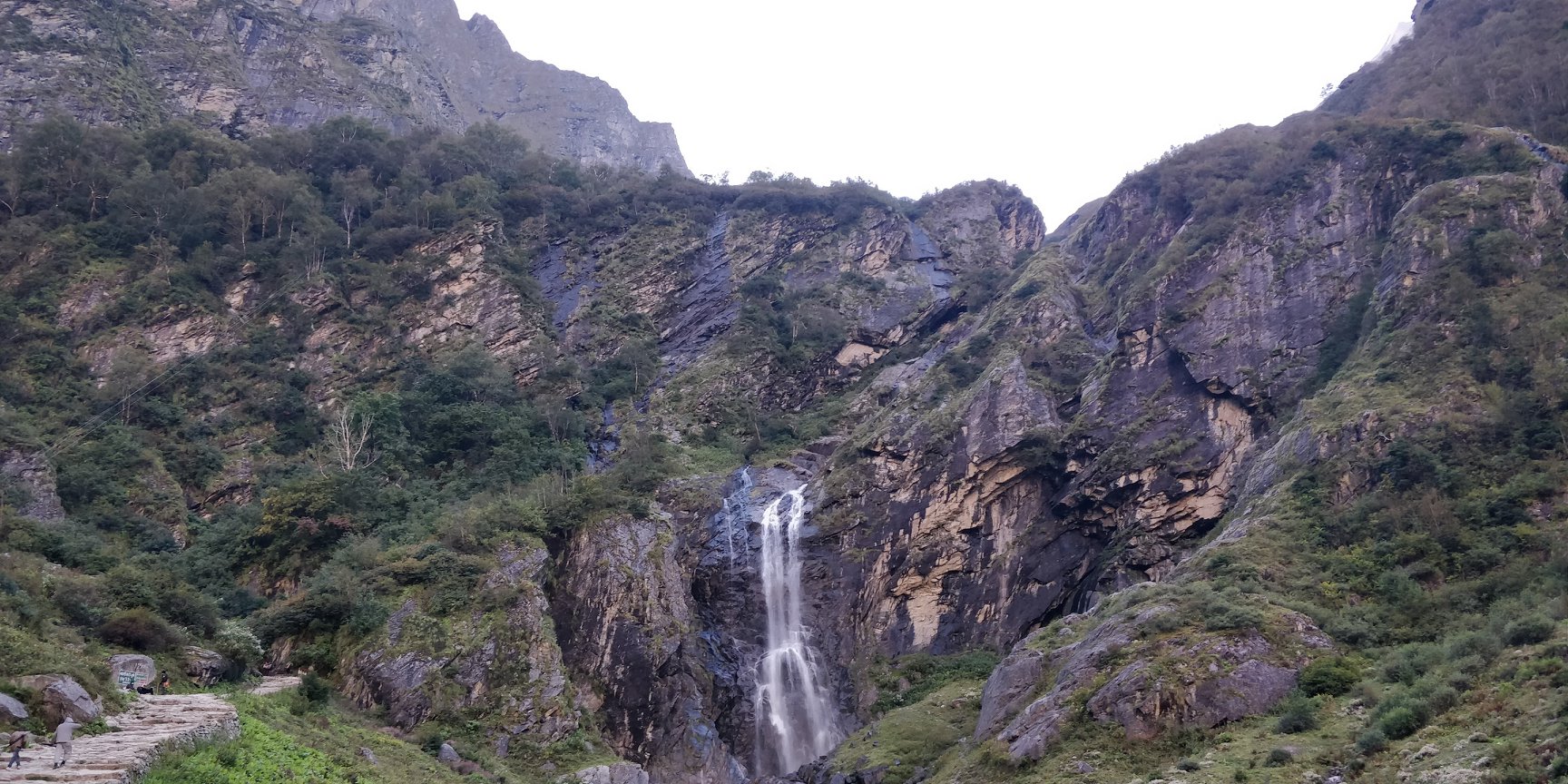
The highlight at the start of the Hemkund Sahib trek is this perennial waterfall. What you see on the extreme left is the trail to Hemkund Sahib.
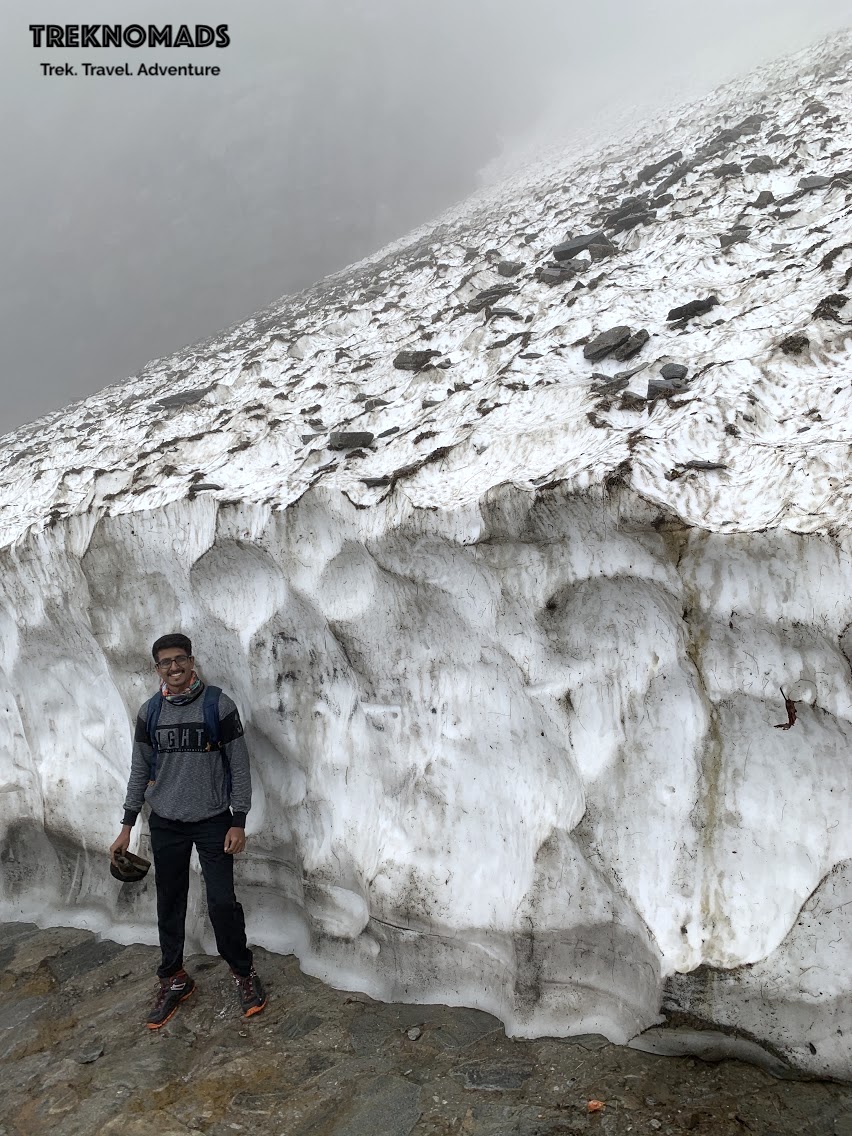
In early June and July, you can find ice on the Hemkund Sahib trail, making this trek even more thrilling.
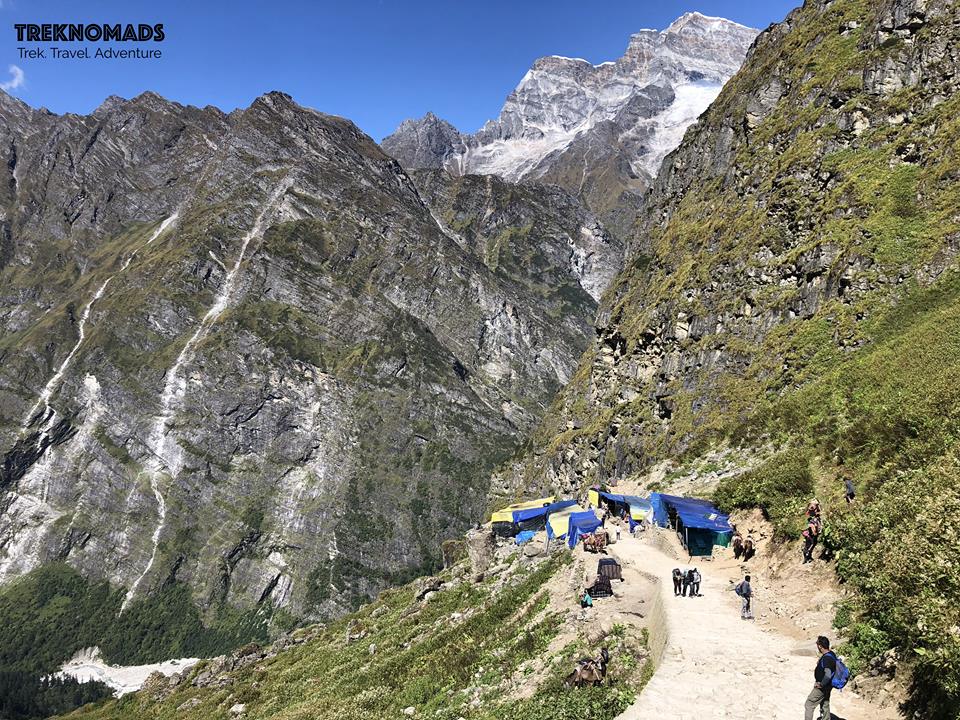
The long and steep trail to Hemkund Sahib, this is where your endurance gets tested.

The first glimpse of the Gurudwara and you can see a small sneak peek of the lake Hemkund behind the Gurudwara.
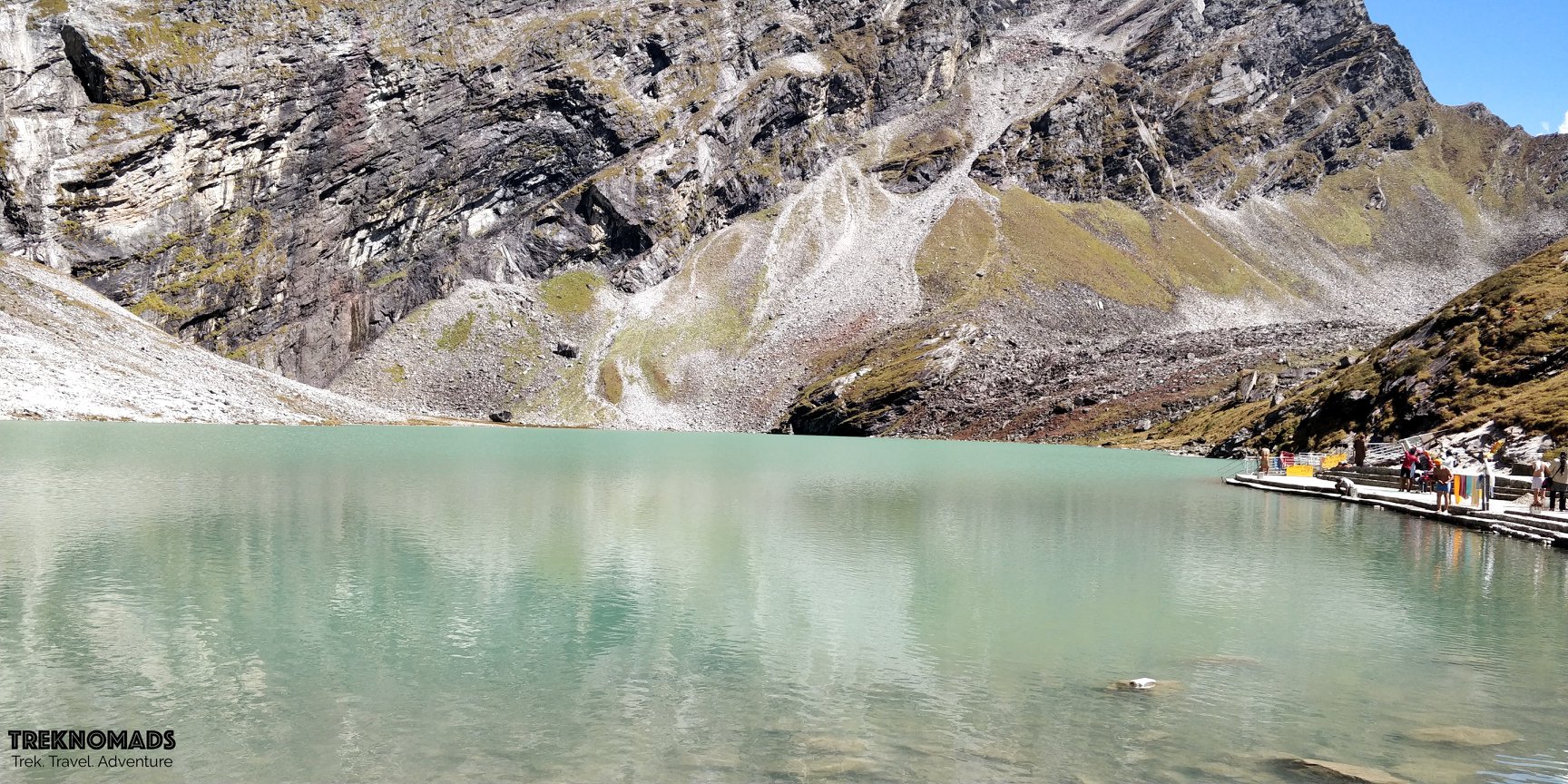
The pristine and diving Hemkund Lake.
Day 6: Valley of Flowers Trek
Altitude: 12,002 ft (3,658 m)
Trek Distance / Duration: 7-8 kms / 5-6 hours
Trek to the UNESCO's World Heritage site, the Valley of Flowers trek. Visit the famous Legge's grave and some of the most picturesque spots in the valley. Stay the night in Ghangariya.
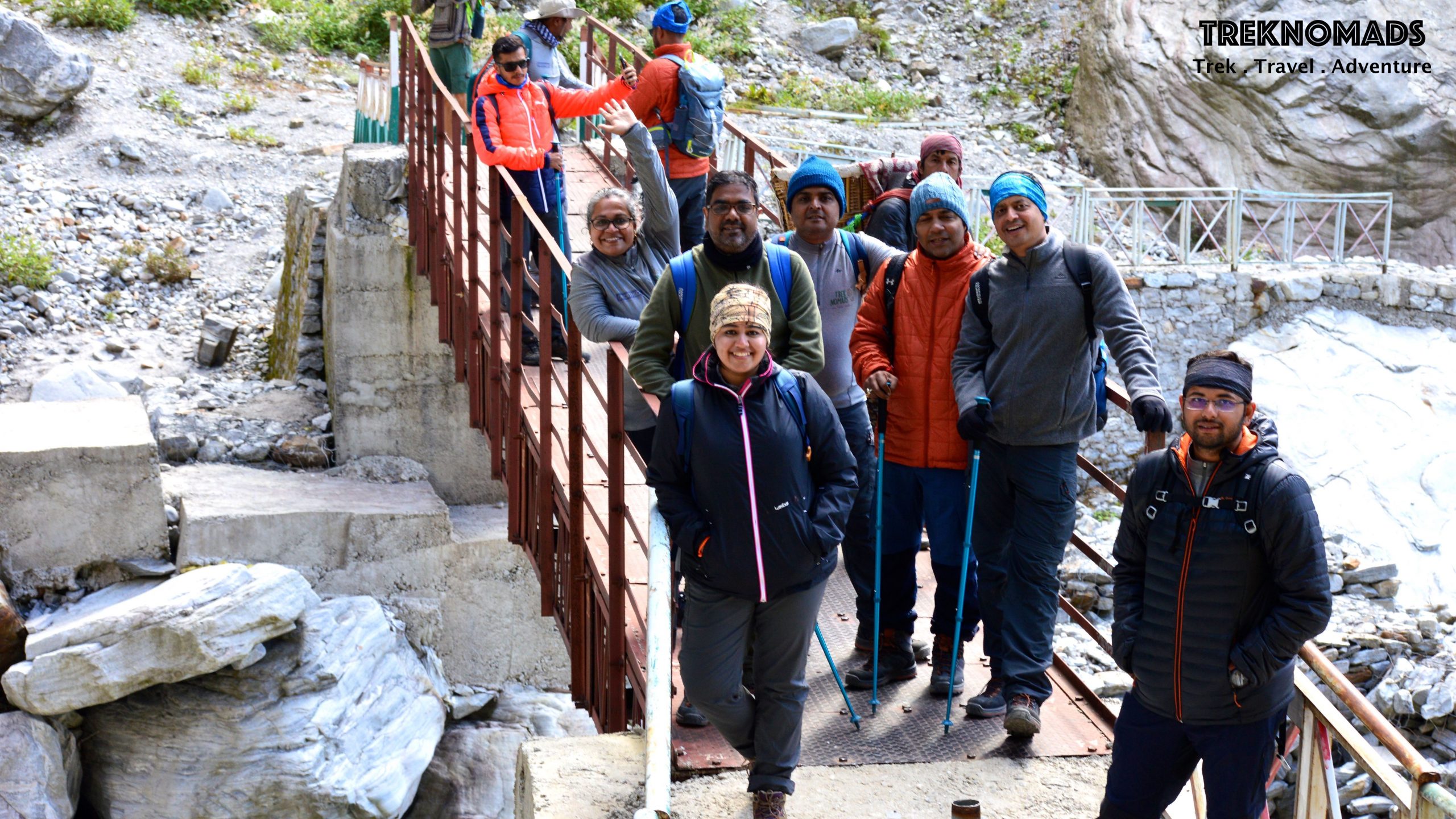
The iconic bridge that you cross at the start of the Valley of Flowers trek.
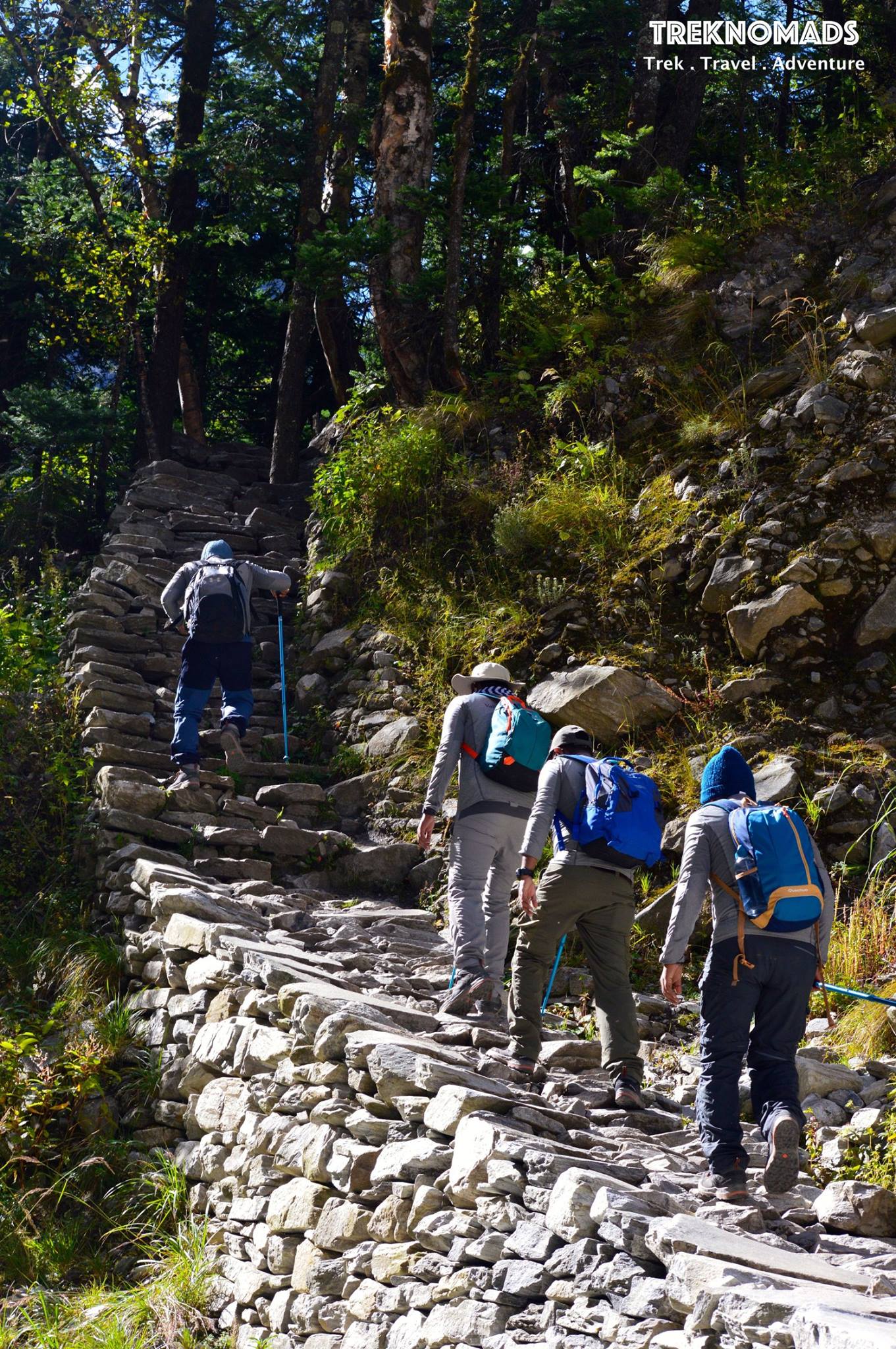
The rocky trail that you have to climb through a small forest before reaching the opening.
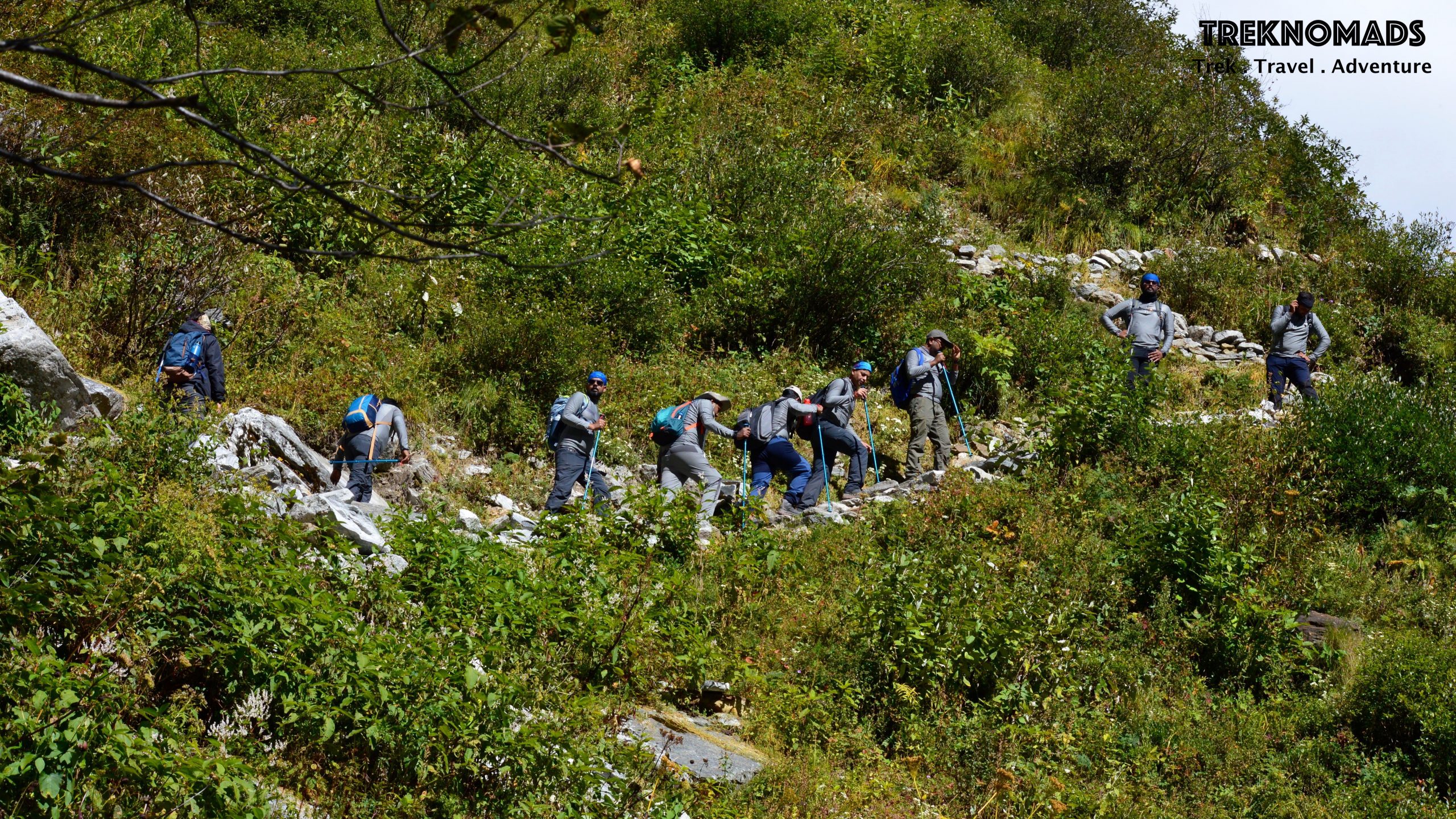
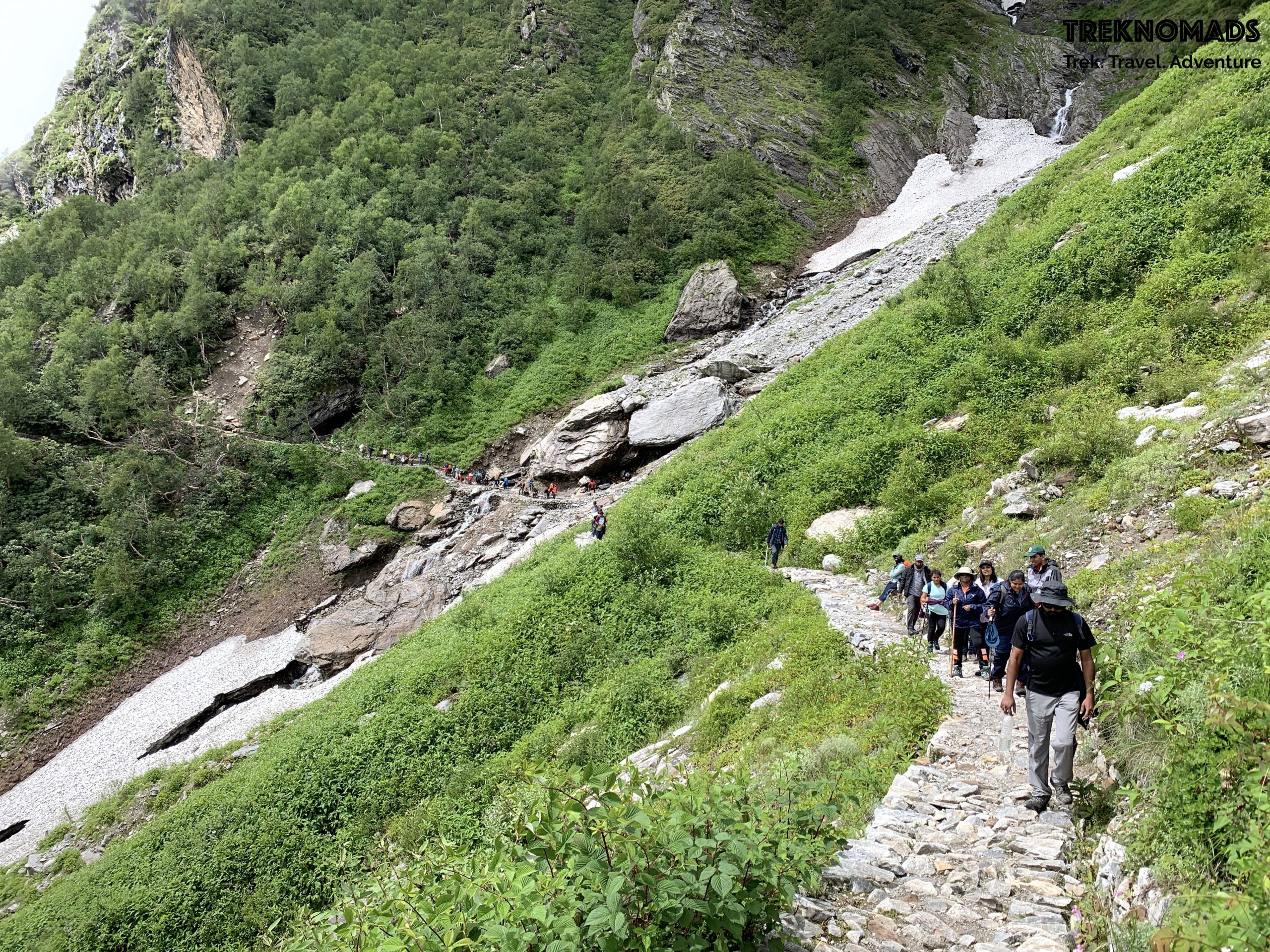
The trail once the rocky path opens up.
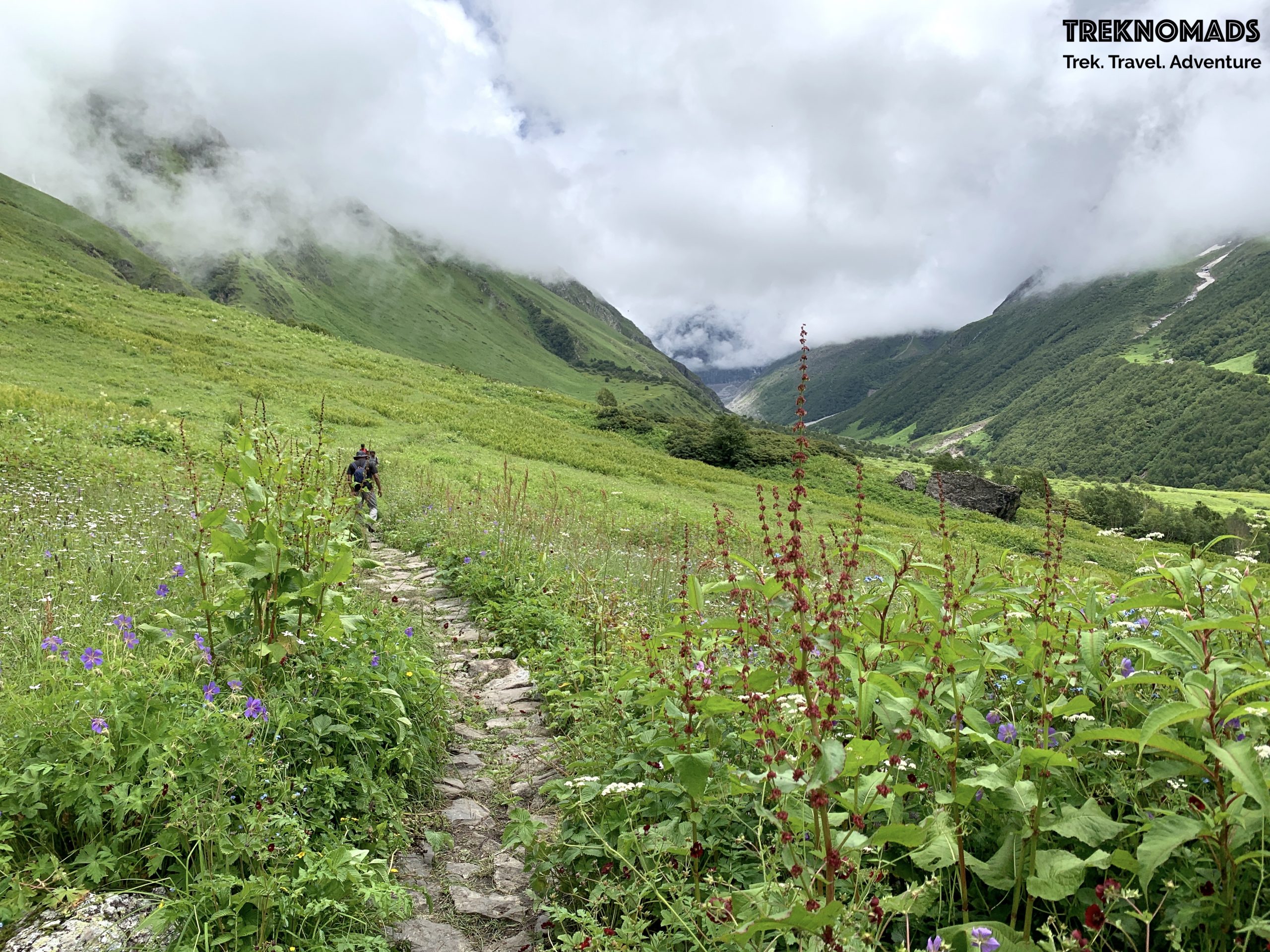
Entering the gorgeous Valley of Flowers!
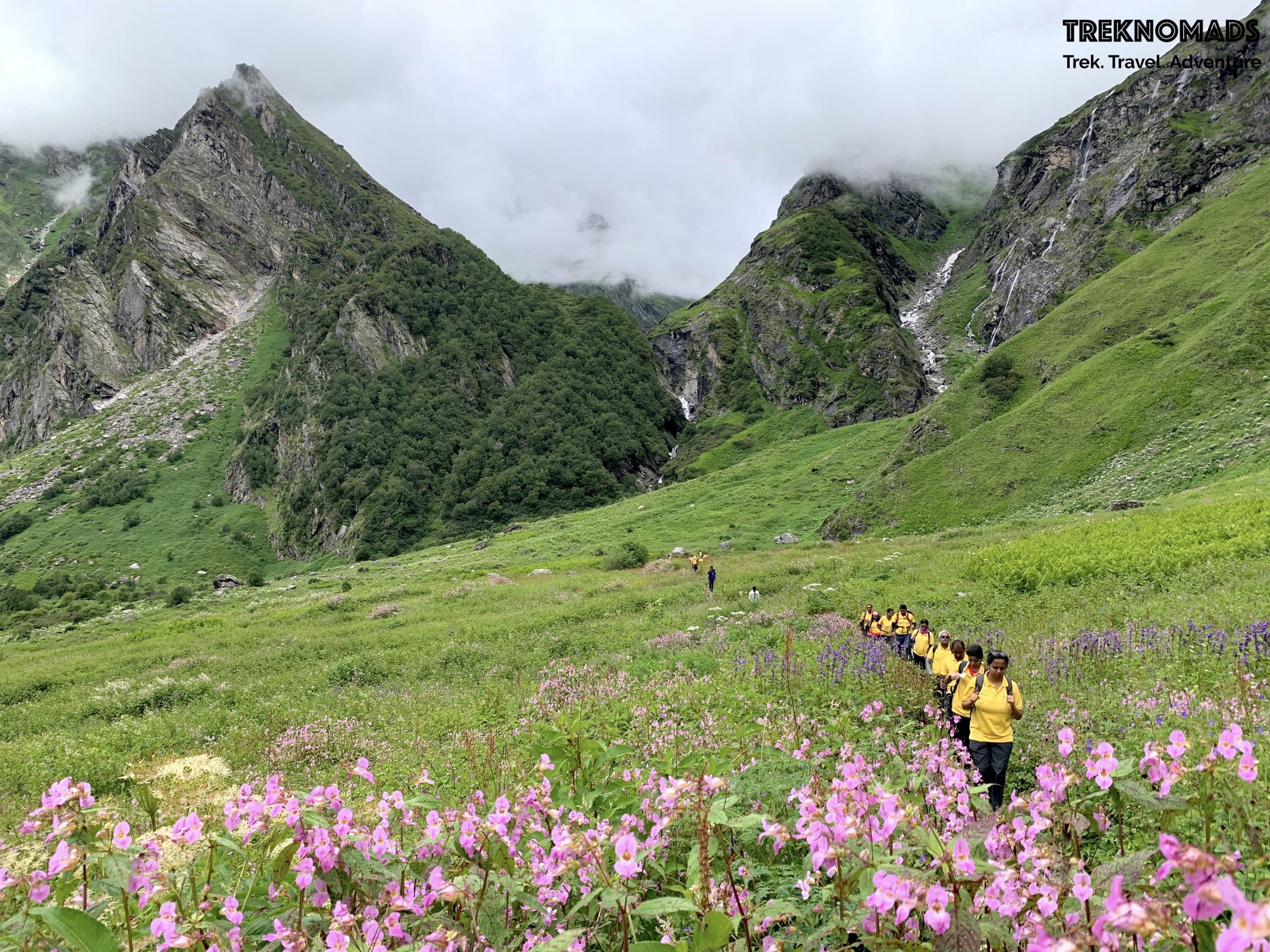
Carpeted in flowers.
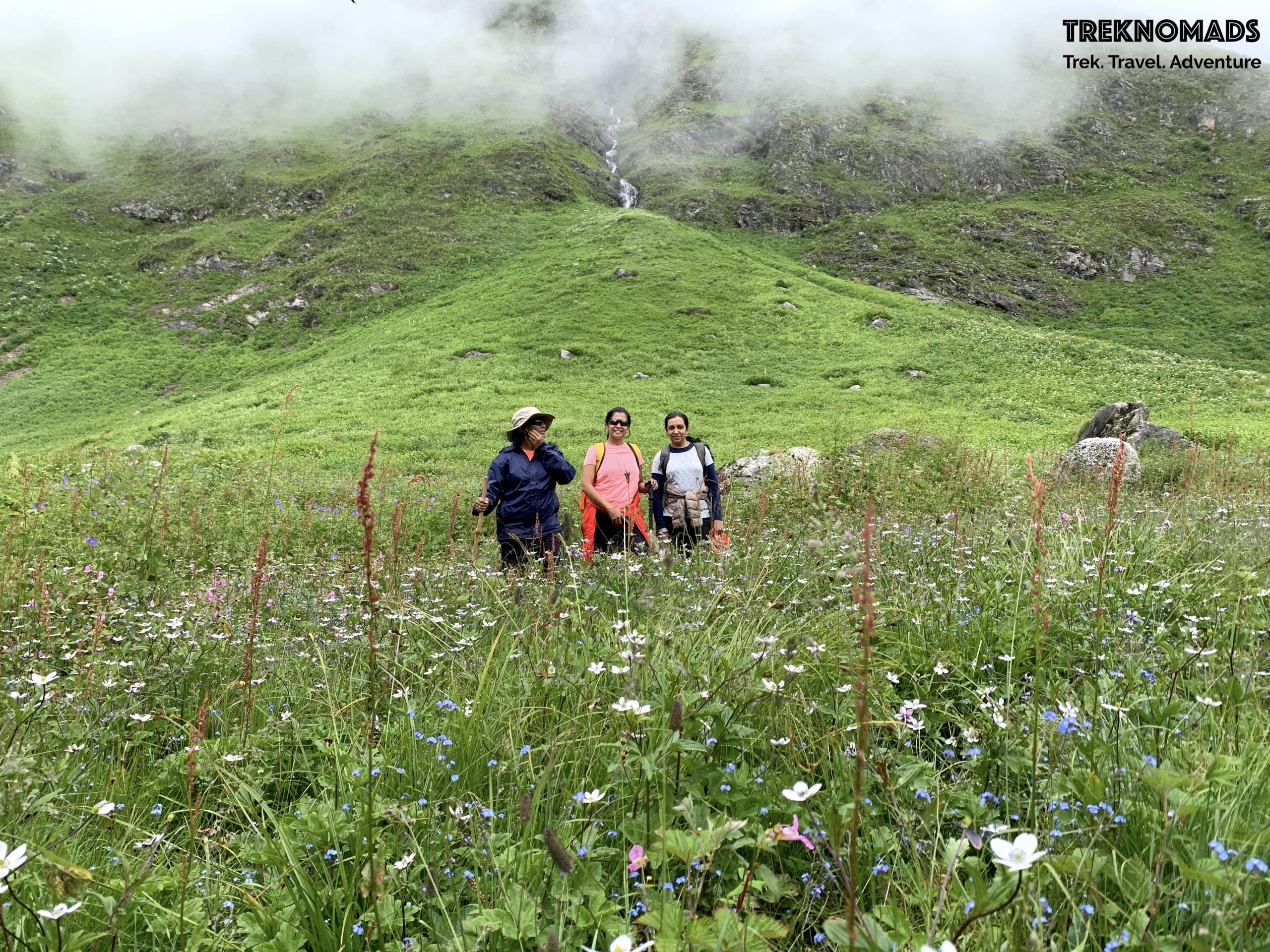
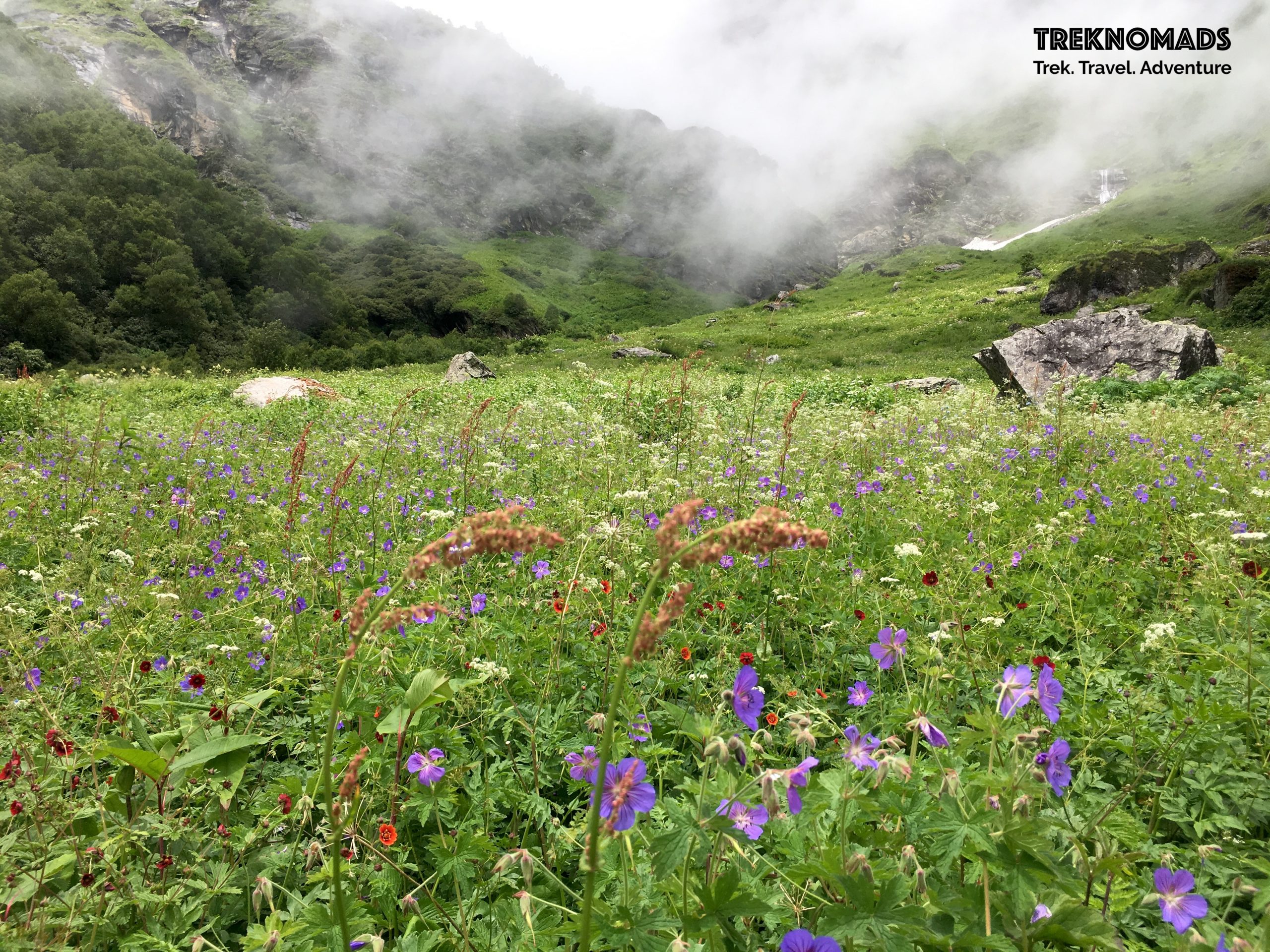
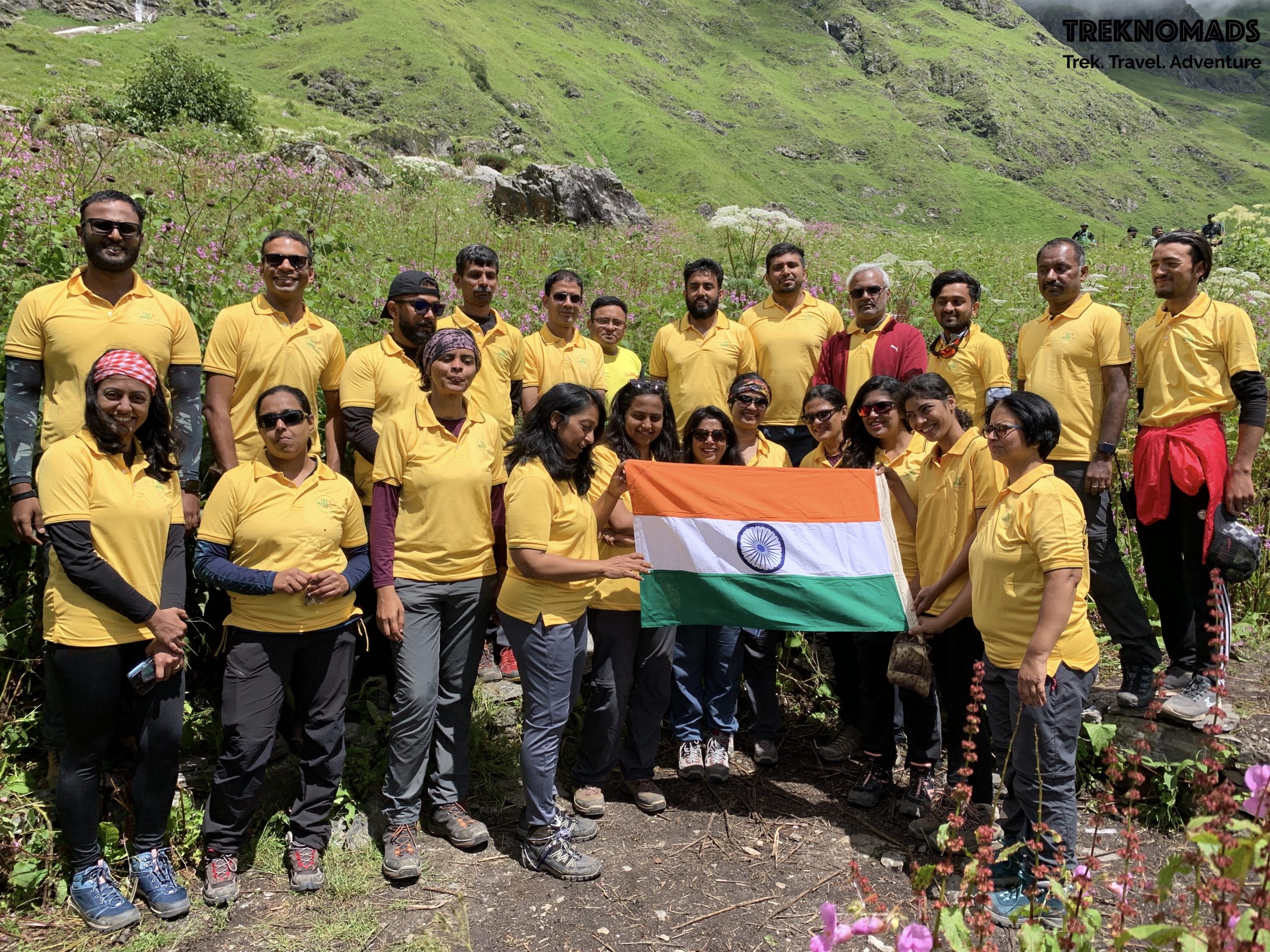
At Legge's grave.
Day 7: Badrinath and Mana Village*
Altitude: 6,150 ft (1,875 m)
Trek Distance / Duration: 10 kms / 3-4 hours
Travel Distance / Duration: 60 kms / 3-4 hours
Trek back to Govindghat from Ghangariya and visit the holy Badrinath Temple and India's last village, Mana (this depends on the time taken to descend back to Govindghat from Ghangariya and only if weather permits). Badrinath to valley of flowers trek distance is 25kms. Stay the night in Joshimath.

The Badrinath temple, one of the Char Dhams in India.

A short visit to Mana before we head back to Joshimath.
Day 8: Rishikesh
Altitude: 1,030 ft (312 m)
Travel Distance / Duration: 250 kms / 8-10 hours
On your last day, you travel back to Rishikesh from Joshimath via road giving you the final few glimpses of the white peaks and the beautiful Himalayas. You will reach Rishikesh by night time or late evening. Stay the night in Rishikesh.
Day 9: Your City
Today you travel back to your city.
Trek Insurance for Valley of Flowers Trek
Trekking in the Himalayas comes with its own set of risks. While adventure is fun and can be extremely thrilling, nature can be unpredictable, and to help secure you during your trek, it is of utmost importance that you are covered with insurance.
We've gone a step ahead and made sure that you don't have to worry about scouting for the best insurance option out there. When you trek with us, your insurance comes as a part of your inclusions. To know more about the benefits covered and sum insured, click here.
Risk and Liability for Valley of Flowers Trek
We will endeavor to make your program smooth and as pleasant as possible. However, the entire course of trekking depends on the ranges of the mighty mountains, physical health, and environmental conditions. Therefore, TrekNomads shall not be responsible for any changes in the itineraries due to unavoidable circumstance and natural disasters such as landslide, road blockage, flood, snowing, cancellation of flight and delay, any types of sickness including altitude sickness
Fitness Criteria for Valley of Flowers Trek
High-altitude/Himalayan treks require every participant to maintain a certain form of physical fitness that will help them trek with ease. A good fitness regime followed by a healthy diet can help you get fit for a Himalayan/high-altitude trek. However, it is advised that you consult with your doctor and then participate in a Himalayan/high-altitude trek.
- Begin your training about 6 weeks before your departure
- Focus on building your stamina through Aerobics, Running, Stair Climbing, Swimming or Cycling about 3 - 4 times a week
- Build your core strength with resistance training through Squats, Lunges, Hip Hinging, Step Ups, Planks at least 3- 4 times a week
- Work on developing a breathing rhythm and expanding your lung capacity with deep breathing and Yoga
- As your trek approaches, head out on smaller treks to help you acclimatize yourself
- Don't miss out on exercising if you can help it, even a 30-minute workout regime followed religiously can take you a long way.
Cancellation Policy for Valley of Flowers Trek:
With the changing travel advisories and newer regulations coming into the picture, we understand that deciding and booking a trek can get tricky. We have relaxed our cancellation policy, read our new terms and conditions for cancellation here
Do’s and Don’ts for Valley of Flowers Trek:
- We believe in leaving the mountains in a better condition, which is why we follow a no-litter policy on our treks. Each trekker will have to bring back the waste that is created during the trek.
- Trekking is best enjoyed when you’ve worn comfortable clothes. Try and avoid wearing Jeans, bright colours and heavy apparels as much as possible.
- A lighter backpack always helps you have a better trek, try and carry just as much as needed.
- Always be in sight of your trek lead, if you feel the need to stop for any reason at all, please keep the trek lead informed.
- If you do come across any reptiles, animals or even insects during the trek, please keep your calm and let it patiently pass by. Any kind of noise and panic will scare them as well.
- Do not venture out into the forest/waterfalls on your own as it may be dangerous.
- Trekking is a good adventure, having said that, it is our primary responsibility to take good care of ourselves and be compassionate towards fellow trekkers
- If, at any point, during the trek, you feel uneasy or unwell, please inform the trek lead immediately
- Tune in to the sounds of nature while on a trek and avoid carrying speakers or playing music during the course of the trek
- To help you enjoy the trek to the fullest, we avoid smoking and consumption of alcohol, and other intoxicants during the course of the trek
You need more information?
What is included in the tour
- Transportation to & fro from Rishikesh in a private vehicle
- 2 nights 3-star hotel stay with breakfast at Rishikesh
- 3 nights resort stay at Auli
- 3 nights hotel stay at Ghanghariya
- Accommodation on a double-sharing basis
- Porter for 1 - 60 ltr Bag (Max 10 kgs)
- 1 litre of mineral drinking water every day in the room
- Snacks box during trekking days
- Entry Permit Fee, Guide Fee & Driver Bata
- Standard vegetarian food for breakfast, lunch, evening snacks, and dinner during trek days
- Visit Badrinath and Mana Village (if and only if time and weather permit)
- 9 days of trekking with an experienced, English-speaking and government-licensed trek guide and assistant trek guide (Number of guides depending on the group size)
- 1 Mountaineering qualified & professional trek Leader
- Insurance, meals, transportation daily salary of guide & porter
- Basic First aid Kit with a portable oxygen cylinder
- Personal accident insurance
- All government, local taxes and service charges
- TrekNomads Fee, Trek Captain support and expertise
- ~15% discount on Fast&Up products
- 15% discount on BMore products
- Personalized Dri-Fit T-shirt
- TrekNomads goodies
What is NOT included in the tour
- The cost to reach Rishikesh and back
- Airport Pick up and Drop Off
- Personal trekking gear
- Tips for guide, chef, porter, etc (calculated per person)
- Excess baggage charges, if it exceeds 10 kg
- Local sightseeing and entrance fee, camera fee, etc
- Mineral water or any type of soft drinks
- Hot water for shower, etc, during the trek
- Extra meals apart from inclusions
- Food during travel days
- Lunch and dinner at Rishikesh 3-star hotel stay
- Any other tickets like cable chair, cable car, etc.
- Any other expenses incurred apart from inclusions
- All personal, medical, evacuation and emergency expenses like extra day stay out of itinerary, helicopter services and vehicle charges due to delays, landslides, evacuation
- Expenses incurred for guide or porter during extra days stay, transport, flight, helicopter service, etc (divided amongst the group which utilises the services of guides/porters on extra days)
Altitude Map:
- Joshimath: 6,150 ft (1,875 m)
- Auli: 8,366 ft (2,550 m)
- Gorson Bugyal: 10,544 ft (3,214 m)
- Govindghat: 5,997 ft (1,828 m)
- Ghangariya: 10,003 ft (3,049 m)
- Hemkund Sahib: 15,200 ft (4,633 m)
- Valley of Flowers: 12,002 ft (3,658 m)
- Badrinath: 10,828 ft (3,300 m)
- Mana: 10,561 ft (3,219 m)
Other Details:
- Trek Gradient: Moderate
- Trek Distance: 40+ Km
- Assembling Point: Rishikesh
- Average Temperature: 5°C to 20°C
- Travel Distance: 720+ Km
- Best Months to trek: June, July, August, September
Valley of Flowers Trek FAQs
What is the valley of flowers trek difficulty level?
The valley of flowers trek difficulty level ranges from easy to moderate. The treks from Govind Ghat to Ghangariya, Ghangariya to Valley of Flowers, and Hemkund Sahib are all well-defined man-made paths, making it a relatively easy trek. If you think the trek is too difficult, you can always hire a pony or a Dholi to complete it for additional charges. However, we recommend walking the entire trail to fully appreciate its beauty.
When is the valley of flowers trek best time?
Valley of flowers trek best time is supposed to be from June to September are the best months to do the Valley of Flowers Trek as you get to see 520 species of high altitude plants including angiosperms, gymnosperms, and pteridophytes, of which 498 are flowering plants.
What should I carry on the Valley of Flowers trek?
We will share a detailed checklist of all equipment and essential items that you would need to carry on this trek once you register for the trek. If you need any assistance in buying/understanding what to buy for the trek, our team will be happy to help you.
Do I need to carry a medical kit on the Valley of Flowers trek?
Our trek lead/captain will be carrying a basic first aid kit along. We recommend that you carry your personal medication and consult your doctor on the medicines you are required to take for the Valley of Flowers trek.
Do you practice responsible trekking on your treks?
We do not allow plastic on our treks; this means that we do not provide plastic bags, bottles or even lunch boxes on our treks. You will have to carry your own lunch box, water bottle, and cutlery that you will use during the trek. Not only does this help you go plastic-free it also helps prevent litter.
Where is Valley of Flowers trek?
Valley of Flowers National Park is an Indian national park which was established in 1982. It is located in Chamoli in the state of Uttarakhand and is known for its meadows of endemic alpine flowers and the variety of flora. Valley of flowers himalayas trek is the most sought after trek among the trekking community.
What kind of flowers do we get to see in the Valley of flowers?
The Valley of Flowers is endowed with 520 species of high altitude plants including angiosperms, gymnosperms, and pteridophytes, of which 498 are flowering plants.
The Valley of Flowers in Uttarakhand is a haven for shutterbugs and professional photographers, with rich Himalayan flora including several rare medicinal plants such as Aconitum Heterophyllum, A. Falconeri, Arnebia Benthamii, Dactylorhiza Hatagirea, Gymnadenia orchids, Megacarpaea Polyandra, Picrorhiza Kurroa, Podophyllum Haxandrum,
How much valley of flowers trek distance will be covered in the span of 9 days?
We will be covering a distance of around 50km on the Valley of flowers Trek. According to the valley of flowers itinerary, the trek route will be as follows: Govindghat --> Ghanghariya --> VOF-->Ghanghariya--> Hemkund Sahib --> Ghanghariya -->Govindghat. When you add acclamatisation trek in Auli, the Valley of Flowers trek distance will be around 65 Kms in total.
What is the temperature like on the Valley of flowers trek?
Minimum temperature on the trek to valley of flowers in the winter is observed to be 5°C to 20°C. At times, it may go below zero as well especially if it rains or snows. On usual days, valley of flowers trek tempreature is 25°C.
Do I need a porter and mule to carry my luggage during the trek?
Porters and mules come as a part of your inclusion when you trek with TrekNomads. Each trekker can get their rucksack (1 – 60-liter bag that weighs up to 10 kg max) transported by porters without any extra cost all through the trail. However if you wish to book an additional porter or mule, you may speak to the trek lead.
Will there be an ATM available on the trail of Valley of Flowers trek?
There is no ATM facility available in Ghangariya. There are ATM facilities available in Joshimath, however, they too run out of cash very often. We recommend you withdraw the required amount at Rishikesh or while traveling to Rishikesh.
What types of stays/accomadation will be available on Valley of Flowers trek?
The stays all through the trek will be in private rooms with private washrooms:
- 3 star or similar hotel stay in Rishikesh
- Resort stay in Auli
- Semi deluxe stay in Ghangariya
- Resort/hotel stay in Joshimath
What type of toilets/rest rooms will be available on Valley of Flowers trek?
The hotel rooms in Joshimath and Auli will have proper washrooms available. Proper running water and english toilets will be available during the stay on this trek in Ghanghariya also.
Will there be Network Availability in Valley of Flowers trek?
On valley of flowers trip, you will not get a good network signal until Joshimath. You will get 4G network at Auli as well - on day 1. On the trail, you might have intermittent signals on the first and last day of the trek. At the base camp, you will get Jio and BSNL network coverage if the weather conditions are good.
What is the Nearest train station to valley of flowers uttarakhand trek?
Nearest railway stations to the valley of flowers trek Dehradun and Haridwar.
Which is the nearest big city to Hemkund sahib valley of flowers trek? How to reach from here?
Nearest big city to Hemkund sahib valley of flowers trek is Rishikesh. The further journey to Joshimath shall be done by road.
Can you share more details about your valley of flowers trek package?
The valley of flowers uttarakhand trek is a 9-day trek. The valley of flowers trek cost with TrekNomads is Rs. 24,999 per person. To check out departure dates and batch details, valley of flowers trek itinerary, valley of flowers trek package, visit here.
What is the valley of flowers trek itinerary?
The assembling point of the valley of flowers trek is Rishikesh. From RIshikesh, you head towards Joshimath. Joshimath to valley of flowers distance is 21km. And the trek starts from Auli. You can check out detailed valley of flowers trek itinerary here.
What is valley of flowers height? Is acclimatisation really important?
Valley of flowers altitude is as high as15,200 ft. High altitude acclimatisation is the process in which our body becomes accustomed to lower levels of oxygen in the surrounding air. If individuals cannot acclimatise to high altitude, they may suffer from a high-altitude disease, such as acute mountain sickness (AMS) or chronic mountain sickness (CMS).
You will be acclimatising in Auli for a day. There will be an acclimatisation trek to Gorson Bugyal followed by the rest of the trek.

![Valley of Flowers Trek and Hemkund Sahib [Premium] - Tour Valley of Flowers Trek and Hemkund Sahib [Premium] - Tour](https://vl-prod-static.b-cdn.net/system/images/000/326/464/f004eeac1383bb5aea2b18eb9400c343/x600gt/VOF_Banner.png?1730303104)














![Everest Base Camp Trek [Premium] - Tour Everest Base Camp Trek [Premium] - Tour](https://vl-prod-static.b-cdn.net/system/images/000/352/493/2f06596a5543585d0f67bc5c9eabe2dd/x400gt/Everest_Base_Camp.png?1730193514)
![Kashmir Great Lakes Trek [Premium] - Tour Kashmir Great Lakes Trek [Premium] - Tour](https://vl-prod-static.b-cdn.net/system/images/000/414/735/bed5a46f080cd0e89659ed19c0c6d7aa/x400gt/TrekNomads_Website_Banner__13_.png?1730306336)
![Markha Valley Trek [Premium] - Tour Markha Valley Trek [Premium] - Tour](https://vl-prod-static.b-cdn.net/system/images/000/696/989/20d9fde45193baa6c2d7e0a59e6354d8/x400gt/ladakh-g02a1788ab_1920.jpg?1737791446)


